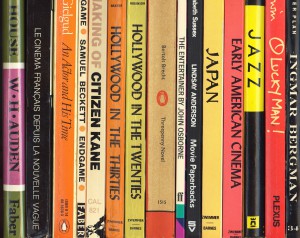In a period when the film critic was becoming more and more integral and popular ideas about the image began to circulate in everyday discussion, silent films, and especially their stars, became increasingly interesting to the general public. Lindsay Anderson’s personal collection of film books houses a number of picture books from this era: collections of stills and glamour shots, occasionally accompanied by descriptions of films or brief histories. These books, besides providing context, stories, and interesting pictures, are a window to two worlds – that of silent cinema and that of its ‘70s revival – which speak to our own.
The biggest difference between these picture books and the few of this kind that were published before 1970 is the shift in intended audience. Older books, like the 1959 Classics of the Silent Screen, call on people’s memories. The introduction appeals to a certain generation, stating its aims as “a rich sampling of some of the highspots of the silent era… to bring back happy memories to those who remember the films and players and to stimulate interest and an eagerness to see them among those who are too young.” For later books, like The Heart of Hollywood or Hollywood Glamor Portraits, the aim becomes more to teach readers about the past and to create a kind of glamorous nostalgia.
Sometimes, the aim is more concrete, as in “ Grandma’s Scrapbook” of Silent Movie Stars , which covertly documents the worth of famous silent actors’ signed photos and teaches readers to distinguish between real and fake signatures while still providing a dizzying collage of artfully assembled glamour shots.

Of course, there were a number of reasons for this revival of interest in Old Hollywood, whether more about the profit to be gained or the pure nostalgia involved. It has been argued that we are experiencing another such revival in the 21st century, but for a much different reason. Slideshows, articles, and “best of” lists from well-known companies like TCM or AFI have in many ways taken the place of these picture books. Widespread accessibility to the Internet means wider access to silent films which would otherwise be much more difficult to find. All the same, these books are an enjoyable window into the past, and a reminder that Old, Old Hollywood is not always so different from our own.
(Abigail Jenkins, M Litt Film, 2015)